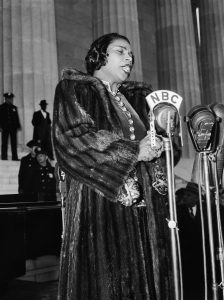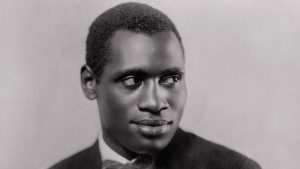Voices of Change: Black Musicians as Advocates for Progress
Part of Classical Music Indy’s ongoing work is to highlight diversity in the classical music world, and explore the unique voices and perspectives of multicultural musicians and audiences. In recognition of Black History Month, Classical Music Indy honors two of the Black musicians who made history by gracing concert stages and bringing unique cultural experiences to the music they performed.
 MARIAN ANDERSON
MARIAN ANDERSON
She walked out onto the steps of the Lincoln Memorial in Washington D.C. and began to sing “My Country, ‘Tis of Thee.” It was April 9, 1939. Hitler’s armies were advancing, the Depression had taken a heavy toll, racial tension was boiling over in the states, but there she was – Marian Anderson – singing for 75,000 people in a public setting in the nation’s capitol. History was made.
Anderson was one of the most prominent classical singers in the country and a beloved figure on the stage. Despite her indisputable fame and world-renowned reputation, many were outraged and outspoken about the fact that she had been given the opportunity to sing in this public setting. Anderson, a poised, intelligent, capable, established, and successful musician of great import was also a black woman. She had been invited to sing as part of the Howard University concert series. Because of Anderson’s tremendous following, the university inquired with Constitution Hall to host the concert, but the Daughters of the American Revolution owned the hall and enforced their, then, white-artist-only clause.
The NAACP assisted Howard University in arranging the outdoor performance on the steps of the monument. For some, sadly, that was worthy of angry protests. In a time of racial divide and political unrest despite much progress, many felt that the prominent role for Ms. Anderson was stoking the fire for those opposed to desegregation. All the more reason, according to many, that she had the opportunity to sing her nation’s anthem on a day that received international attention. Her beautiful singing that day became a testament of strength in the face of adversity that will resonate throughout American history.
 PAUL ROBESON
PAUL ROBESON
Paul Robeson, the booming bass-baritone of the mid-1900’s, was known by most as the voice and face of Show Boat with his iconic rendition of “Old Man River”. Little known by most is that Robeson was also a lawyer and activist, and graduated with honors from Rutgers University. He funded his education by playing professional football for Hammond, Indiana; Akron, Ohio; and Milwaukee, Wisconsin. One of the most famous voices of the 20th century, Robeson was the very definition of a renaissance man. As a prominent figure in the musical world, Robeson used his fame and following to leverage progress in ongoing Civil Rights discussions and debates. His very quick climb to fame was due not only to his powerful singing but his powerful voice in advocating for social justice.
The world today is a very different and much-progressed place. Social justice struggles, equality issues, and gross stigmas continue but many more people are empowered to courageously battle against injustice. Likewise, the classical music stage has continued to become more diverse, more colorful, and imbued with the beautiful multicultural backgrounds of people who once would have been denied opportunity on the stage.
Many others have joined in the journey as stages have diversified and countless musicians of color have earned prominent places among the artistic community, and as part of the multicultural fabric that is today’s America and today’s musical world. Black Americans (and other diverse communities as well) have stepped onto countless national stages to be heard musically while also becoming part of empowering their respective communities to be heard.






Leave a Reply